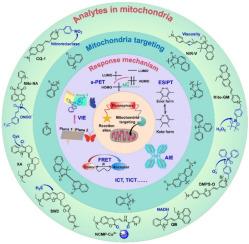线粒体靶向小分子荧光探针的最新进展:从主要设计到生物学应用
IF 23.5
1区 化学
Q1 CHEMISTRY, INORGANIC & NUCLEAR
引用次数: 0
摘要
监测和调节线粒体的功能对疾病管理具有重要的研究价值。小分子荧光探针由于其非侵入性、高灵敏度和实时反馈等优点,已成为研究线粒体结构和功能的有力工具。到目前为止,已经报道了许多基于各种线粒体靶向策略和多种反应机制的荧光探针。因此,本文总结了荧光探针的典型响应机制,包括光致电子转移(PET)、Förster共振能量转移(FRET)、分子内电荷转移(ICT)等。此外,还总结了线粒体靶向探针的策略,如三苯基磷、吡啶、罗丹明衍生物和吲哚衍生物。重点介绍了近年来发展起来的线粒体靶向探针,包括酶、活性氧、黏度等探针。最后,对高性能小分子荧光探针的设计进行了展望。本文章由计算机程序翻译,如有差异,请以英文原文为准。


Recent advances in the mitochondria-targeting small molecule fluorescent probes: from the principal design to biological applications
Monitoring and regulating the functions of mitochondria holds significant research value for disease management. Small molecule fluorescent probes, due to their various advantages including noninvasiveness, superior sensitivity, and real-time feedback, have emerged as powerful tools for studying the structure and function of mitochondria. Until now, numerous fluorescent probes based on various mitochondrial targeting strategies and multiple response mechanisms have been reported. Therefore, we herein summarize the typical response mechanism of the fluorescent probes, including photoinduced electron transfer (PET), Förster resonance energy transfer (FRET), intramolecular charge transfer (ICT), etc. In addition, the strategies for mitochondria-targeting probes, such as triphenylphosphonium, pyridinium, rhodamine derivatives, and indolium derivatives, are also concluded. Specially, the mitochondria-targeting probes developed in recent years are highlighted carefully according to the analytes, including probes responding to enzymes, reactive oxygen species, viscosity, etc. At last, a detailed outlook for designing high-performance small molecule fluorescent probes is provided.
求助全文
通过发布文献求助,成功后即可免费获取论文全文。
去求助
来源期刊

Coordination Chemistry Reviews
化学-无机化学与核化学
CiteScore
34.30
自引率
5.30%
发文量
457
审稿时长
54 days
期刊介绍:
Coordination Chemistry Reviews offers rapid publication of review articles on current and significant topics in coordination chemistry, encompassing organometallic, supramolecular, theoretical, and bioinorganic chemistry. It also covers catalysis, materials chemistry, and metal-organic frameworks from a coordination chemistry perspective. Reviews summarize recent developments or discuss specific techniques, welcoming contributions from both established and emerging researchers.
The journal releases special issues on timely subjects, including those featuring contributions from specific regions or conferences. Occasional full-length book articles are also featured. Additionally, special volumes cover annual reviews of main group chemistry, transition metal group chemistry, and organometallic chemistry. These comprehensive reviews are vital resources for those engaged in coordination chemistry, further establishing Coordination Chemistry Reviews as a hub for insightful surveys in inorganic and physical inorganic chemistry.
 求助内容:
求助内容: 应助结果提醒方式:
应助结果提醒方式:


